Keychron K3 review: a classic mechanical keyboard in a modern compact form
The Keychron K3 is a particularly well-designed slimline mechanical keyboard, but its chief competition is other keyboards from the same manufacturer.
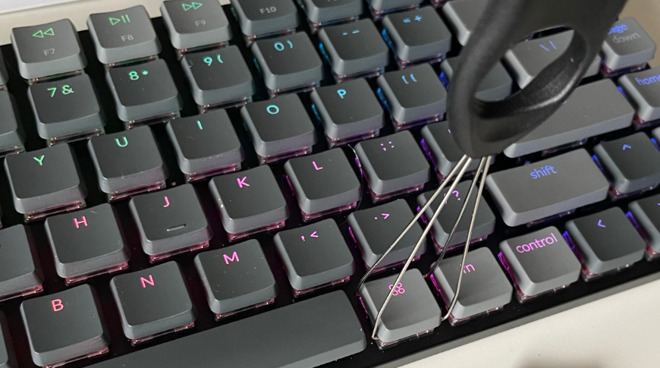
The Keychron K3 can feature hot-swappable keys
If you don't like mechanical keyboards, then the Keychron K3 is not going to change your mind -- but it might come close. It's larger than the kind of chiclet keyboard you get from Apple, yet slimline and small compared to most other mechanical ones.
Then if you do like mechanical keyboards, you're not going to lose any of the feel or the sound by going for this. It manages to be compact without any obviously overt compromise on the travel of the keys or the rigidity of the keyboard.
Keychron's latest keyboard follows its highly praised K2 predecessor, and the similarly rated K1 before it, in providing a solid, comfortable typing experience. Its predecessors are still available, though, and the addition of the Keychron K3 -- plus the forthcoming K4 -- means that it's tricky to choose.
What makes the K3 stand out is chiefly is business that it is built to be compact. It's compact enough that Keychron sells a separate travel pouch, plus a lightweight palm rest.
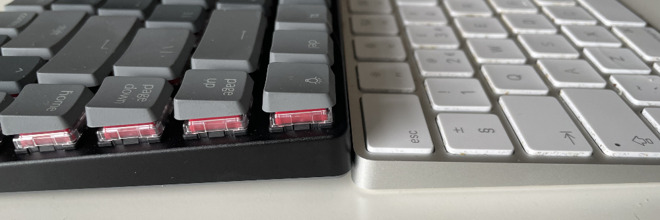
L: Keychron K3. R: Apple Magic Keyboard
The sturdy aluminum body houses one of two types of key switches, an optical or a mechanical one. Either allows you to swap the keycaps to, for instance, make a Windows layout instead of a Mac one.
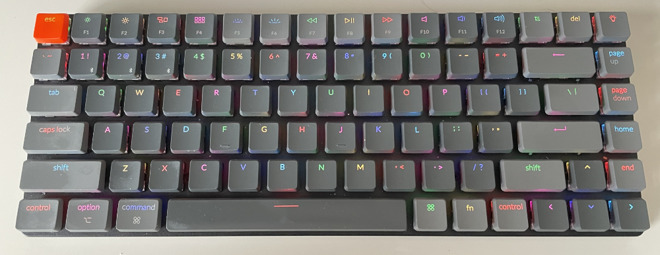
If it's hard to justify flashing backlight colors, it's also hard to dislike them
Keychron's low-profile optical switch version goes further and features hot-swappable caps and keys, meaning you can change both without switching off the keyboard.
Then for that optical switch version, there are six further options, each of which is claimed to be 40% slimmer than current regular switches.
These six switches include the best-known red and blue varieties, plus brown, white, black, and orange. This is really how mechanical keyboards get their flavor, as each type of switch produces a subtly different feel -- and sound.
Broadly, blue switches are loud, they need a firm press, and you can hear a distinct click as you type. Red switches are easier to press, needing less pressure, and tend to be quieter.
The others fall in between these two, and it is hard to accurately predict which will suit you the best. That said, though, they all make noise and require more typing pressure than the kind of chiclet keyboard that Apple sells.
This means that while there are these sometimes quite subtle differences, but overall you either like a mechanical keyboard or you don't. So if you like the sound and the harder typing pressure, you'll be happy whichever switch type you get.
AppleInsider tested red switches, and Keychron also supplied a full set of blue. You can buy blue or brown switches separately and swap out each key switch yourself, if you have the low-profile optical edition of the Keychron K3.
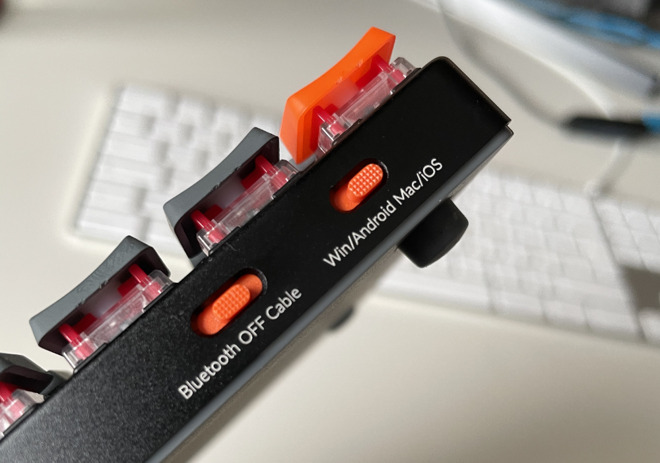
As well as being able to connect to three devices, switches on the back let you choose Bluetooth or cable connection, plus PC or Mac configurations.
This is a multi-colored backlight where, amongst many other options, you can have it that different color lights flash as you type. You can set one color to show all the time, too, or have moving patterns across the keys.
Backlighting isn't especially helpful when you're a touch typist, but even when you are, it is oddly restful having these colors play across the keys. If you dislike that, you can switch off the backlight -- or buy the White Backlight version instead.
Where you don't get any choice at all, though, is in the typing angle. The Keychron K3 comes with one angle, marked by both a slight slope on the keys, and double-height rubber feet at the rear.
In regular use, that angle is fine and the keyboard feels good. Moving to it from a low-lying Apple Magic Keyboard, though, takes some adjustment because your hands are best positioned slightly higher than the bottom row.
The separate palm rest helps elevate your hands to that level. Though note that it is a truly separate rest -- it does not connect to the keyboard and simply sits in front. This means that depending on the surface the rest is on, it can slip.
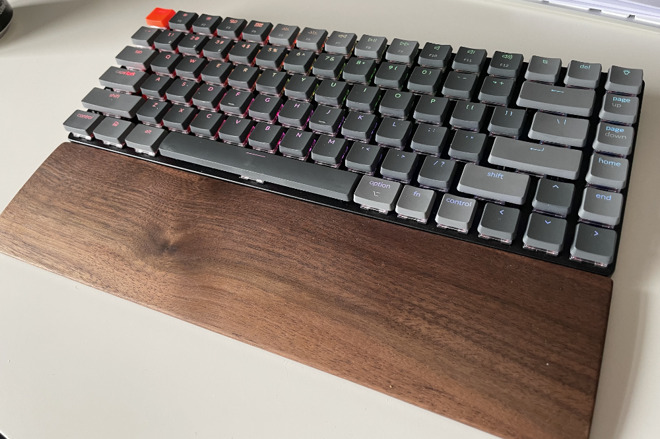
There's only one typing angle and the keyboard is taller than a standard Apple one, so this separately sold palm rest is useful
Keychron sells the palm rest separately. It comes in versions built to suit different Keychron keyboards, but all cost $25.
But then as soon as you've pressed a replacement into place, it is as if the new key was always there.
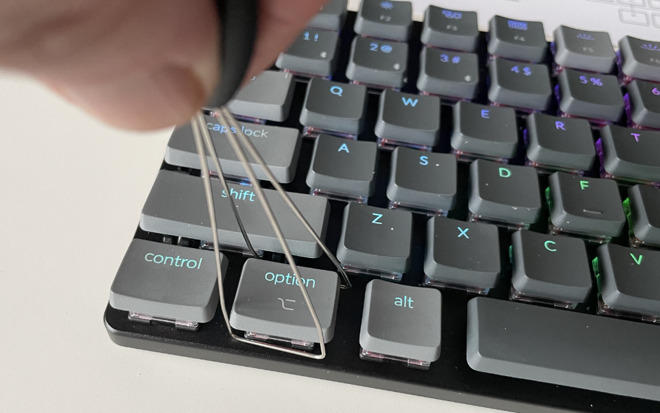
Removing a key or a key switch is particularly easy
There is more you can do besides changing layout to fit Windows or Mac. You can, for instance, decide against Keychron's default orange Escape key and replace it with a plain one.
What you can't do, though, is replace the US-style Enter key with, for instance, a European-style Return. Those keys are different shapes, and while Keychron sells many keyboards in these different configurations, the Keychron K3 is currently only available in the US style.
Perhaps more likely to affect your buying decision is how there's no option for a numeric keypad. That's obviously deliberate and part of making this a compact keyboard, but it would good to have an optional, separate keypad.
Add to that how customizable it is with different keycaps, and even switches, and it is a particularly good buy -- if you like mechanical keyboards and don't want a numeric keypad.
Pros

The Keychron K3 can feature hot-swappable keys
If you don't like mechanical keyboards, then the Keychron K3 is not going to change your mind -- but it might come close. It's larger than the kind of chiclet keyboard you get from Apple, yet slimline and small compared to most other mechanical ones.
Then if you do like mechanical keyboards, you're not going to lose any of the feel or the sound by going for this. It manages to be compact without any obviously overt compromise on the travel of the keys or the rigidity of the keyboard.
Keychron's latest keyboard follows its highly praised K2 predecessor, and the similarly rated K1 before it, in providing a solid, comfortable typing experience. Its predecessors are still available, though, and the addition of the Keychron K3 -- plus the forthcoming K4 -- means that it's tricky to choose.
What makes the K3 stand out is chiefly is business that it is built to be compact. It's compact enough that Keychron sells a separate travel pouch, plus a lightweight palm rest.

L: Keychron K3. R: Apple Magic Keyboard
Design -- switches and keys
Keychron describes this as an ultra-slim keyboard, and says that it is 75% of a full-size one. In practical use, it's visibly compact but not to the extent that it's noticeable when typing.The sturdy aluminum body houses one of two types of key switches, an optical or a mechanical one. Either allows you to swap the keycaps to, for instance, make a Windows layout instead of a Mac one.

If it's hard to justify flashing backlight colors, it's also hard to dislike them
Keychron's low-profile optical switch version goes further and features hot-swappable caps and keys, meaning you can change both without switching off the keyboard.
Then for that optical switch version, there are six further options, each of which is claimed to be 40% slimmer than current regular switches.
These six switches include the best-known red and blue varieties, plus brown, white, black, and orange. This is really how mechanical keyboards get their flavor, as each type of switch produces a subtly different feel -- and sound.
Broadly, blue switches are loud, they need a firm press, and you can hear a distinct click as you type. Red switches are easier to press, needing less pressure, and tend to be quieter.
The others fall in between these two, and it is hard to accurately predict which will suit you the best. That said, though, they all make noise and require more typing pressure than the kind of chiclet keyboard that Apple sells.
This means that while there are these sometimes quite subtle differences, but overall you either like a mechanical keyboard or you don't. So if you like the sound and the harder typing pressure, you'll be happy whichever switch type you get.
AppleInsider tested red switches, and Keychron also supplied a full set of blue. You can buy blue or brown switches separately and swap out each key switch yourself, if you have the low-profile optical edition of the Keychron K3.

As well as being able to connect to three devices, switches on the back let you choose Bluetooth or cable connection, plus PC or Mac configurations.
Design -- backlighting and typing angle
What you can't do after purchase with any option is change the backlighting. You have to choose between a white backlight or what Keychron calls an RGB one.This is a multi-colored backlight where, amongst many other options, you can have it that different color lights flash as you type. You can set one color to show all the time, too, or have moving patterns across the keys.
Backlighting isn't especially helpful when you're a touch typist, but even when you are, it is oddly restful having these colors play across the keys. If you dislike that, you can switch off the backlight -- or buy the White Backlight version instead.
Where you don't get any choice at all, though, is in the typing angle. The Keychron K3 comes with one angle, marked by both a slight slope on the keys, and double-height rubber feet at the rear.
In regular use, that angle is fine and the keyboard feels good. Moving to it from a low-lying Apple Magic Keyboard, though, takes some adjustment because your hands are best positioned slightly higher than the bottom row.
The separate palm rest helps elevate your hands to that level. Though note that it is a truly separate rest -- it does not connect to the keyboard and simply sits in front. This means that depending on the surface the rest is on, it can slip.

There's only one typing angle and the keyboard is taller than a standard Apple one, so this separately sold palm rest is useful
Keychron sells the palm rest separately. It comes in versions built to suit different Keychron keyboards, but all cost $25.
Switching keys
Keychron provides a tool for lifting keys, and switches, off the keyboard. The first time you do it, you do feel as if you're breaking off the keycap.But then as soon as you've pressed a replacement into place, it is as if the new key was always there.

Removing a key or a key switch is particularly easy
There is more you can do besides changing layout to fit Windows or Mac. You can, for instance, decide against Keychron's default orange Escape key and replace it with a plain one.
What you can't do, though, is replace the US-style Enter key with, for instance, a European-style Return. Those keys are different shapes, and while Keychron sells many keyboards in these different configurations, the Keychron K3 is currently only available in the US style.
Perhaps more likely to affect your buying decision is how there's no option for a numeric keypad. That's obviously deliberate and part of making this a compact keyboard, but it would good to have an optional, separate keypad.
Should you buy the Keychron K3
At $74 for the white backlight version, and $84 for the multi-color RGB one, the Keychron K3 is an excellent keyboard for a good price. It has a very distinct feel, and sound, but it is compact enough for it to be truly portable.Add to that how customizable it is with different keycaps, and even switches, and it is a particularly good buy -- if you like mechanical keyboards and don't want a numeric keypad.
Pros
- Compact design
- Enjoyable typing experience
- Able to switch quickly between multiple devices
- Can come with many backlighting options
- Picking the right switch for you is daunting
- No numeric keypad option
- Only one typing angle

Comments
All of the Keychron keyboards have a selection of switches. Most them have both Gateron mechanical and optical variants so if you prefer a relatively quiet keyboard, just select it.
Some people mod their Keychrons nevertheless.
Like Longterm I actually own a Keychron keyboard, several in fact: two K1s, a K8 and one of the just-released C1s. I favor the quietest Gateron Red mechanical switches.
The K8 and C1 are pretty equivalent in feel. Both are the best keyboards I have used in the past twenty years. Maybe there was an ALPS based keyboard in the Nineties that was better. I loved the keyboard on the old IBM Selectric typewriters. That's about as close as these two Keychron keyboards get.
This is my only hurdle in choosing a mechanical keyboard. I don't really need clicky-clacky for the sake of the sound. I've got a Matias that does that, and I pretty much got my fill with Apple Extended keyboards anyway.
The key feature for me of this KeyChron is the BT/Cable switch. But battery life is important. If it can be used while charging via cable, then it might be a contender.
Yes, I'll get wireless, but will use it wired for the most part.
It did bring up a few questions, though, as I'm considering a mechanical keyboard.
First, the 96% thing. Does that mean it's overall layout/key-spacing is 96% of what 'standard' keyboards are? Maybe that 4% wouldn't matter too much, but I still remember my PowerBook 100 days, where I became incredibly fast on it, but it messed me up for every other keyboard for quite some time (if I ever recovered).
Second, does anyone know how the switch-brands compare? Gateron, Cherry MX? I've been looking at WASD keyboards, but I like the Keychron features (BT option and more Mac-centric nature, etc.) I guess I need to get one of these switch-testers https://www.wasdkeyboards.com/wasd-9-key-cherry-mx-switch-tester.html but I'd like something as close to the Mac Extended II I loved so much years ago. I tried a 'Red' switch in a store the other day (can't remember the brand), but it felt stiffer, 'chalkier', and longer travel than I remember. Maybe my perception is just skewed from using Magic Keyboard and modern laptops (in terms of travel), but I don't recall the other aspects on an AE II.
I've also never considered optical vs mechanical switches. I suppose in theory the optical is better? But, I actually like the 'buckle-over' (right term?) nature of the feel of mechanical switches? So, I'd probably go for the 'tactile' over the 'linear' even though I'd like it to be as quiet as possible too. (Can't have it both ways, I suppose.)
Another question, is about the brief mention of multiple devices. Does this mean the BT connection can switch between, say, iPad, iPhone, Mac? I have that on a Logitech keyboard I bought for travel, and love it... but the Logitech feel really, really sucks! I just got it to have something to go with my iPad/iPhone when I'm away.
And finally, regarding the backlight, can you pick a color and then also set the intensity? The backlight is nice, and so is setting the color, but I'd want to 'tone it down' if possible, depending on how bright it is. Thanks!
So, the layout eliminates about 5 keys from the standard full size keyboard, and squeezes them into as small a footprint as possible. I want the arrow keys and the number pad. I'm a right handed mouse or trackpad user, so reducing the amount of space taken by the keyboard on the right is a big win.
There are left side number pad keyboards. Would have to give that a try one of these days.
There doesn't seem to be any real difference with the research that I've done. The Cherry's are good to 100m presses while the Gateron's are good to 50m presses. Numbers like that are meaningless. 50m presses are like 100 years of pressing a key once a second 24x7x365. If a key fails, it will fail because of something else that will happen much more often, like drinks, food, dust, etc, in the keyboard. Then, the keyboard fans do their own custom mods anyways, which seems much more important than switch brand.
There aren't any differences between the two in the actuation behavior. Optical switches uses a laser to determine when a key is pressed. A regular mechanical switch likely just uses analog electrical contact. The actuation feel is determined by a spring, a buckling rod/bump, and the quality of the piston and socket the key rides on, which all are used by both electrical and optical switches.
If you like buckling action, I do too, you want to use blue switches. They have a little lever with a bump on the end. As you press the key, it rides across this lever until it hits the bump, and after it goes over the bump, makes a little snap sound, and the resistance decreases a lot. Hence the feeling of buckling. This is all independent of when the key pressed signal is sent. For optical, it's likely because the laser signal has been blocked and for electrical, it's either when the contact patches come in contact or are disengaged.
You'll want to try brown or blue switches. The red switches are supposed to be linear, and provide no clicking or buckling feel. There are many different switch actuation behaviors, and they are coded based on color.
It seems most of the wireless Bluetooth keyboards are able to connect to 3 devices or so. They aren't going to be Airpods like, with autoswitching. You don't have to repair, just have the host device switch.
For backlight, all I've seen is people changing light intensity with white light. Haven't seen it done with colored light, though surely this is just a driver or setting that can be done. One thing to be careful of is that you will want to have keycaps that will let the backlight illuminate the lettering on the keycap. Some keycaps don't let the light shine through. Without this, it just isn't going to be good to use in the dark. It's mostly going to look like blank buttons...
Thanks, yeah I'm fine with either. I was concerned with feel. I would suppose there are slight differences from manufacturer to manufacturer, but as long as they are all aiming at being similar, that's probably good enough.
Thanks so much for all the detail here, that's exactly what I needed to know. (Well, and your whole response!)
Yeah, that's how my Logitech works, which is totally fine. It would be *really* nice to be able to relatively-easy switch to my iPad or phone to type from my main desktop keyboard.
Thanks for that tip on the backlight. While that seems obvious, I might have missed that. Yes, this keyboard seems to have clear letters/symbols, whereas some of the other ones I've looked at do not. Just having a glow-effect isn't that helpful just for effect. While I don't look most of the time, I guess, it's more a confidence thing or for symbols or less-used keys.
Unfortunately, it (AEII) seems in a different league, with these keyboards kind of making cheap attempts. But, w/o ADB emulation and given the AEII is pretty darn huge by today's keyboard standards/desk-setups, they are the best we've got.
I'm still quite interested in this keyboard, but I've also found out about some rather troubling characteristics many report of keys triggering at the slightest touch. It seems to be a fundamental flaw with the switch design. I'm not sure if it applies to all types though, so I'll have to wait and keep researching, or wait for a rev-2, I guess. Apparently you can *kind of* fix it with enough work by removing tiny springs (though it has other implications).
cf.
"fix":
I think if I get one (they aren't even in stock right now), I'll just go for the mechanical brown (I might like the blue even better, but getting the sound-level as quiet as possible is also a goal). I suppose the good news for anyone with a flawed optical version, is that since they are swappable, Keytronics could just send them (or make available) a fixed revision of the switches themselves, and that would fix the issue.
Anyone interested in ortholinear keyboards? That may be my next hobby. Buying a PCB, building it, configuring the QMK drivers, and away I go, learning something new. But, this seems even worse than waiting on a 96% keyboard. Long wait times and weird availability.
(And AppleInsider, you can let Keychron know they sold at least one, partly due to this article.)